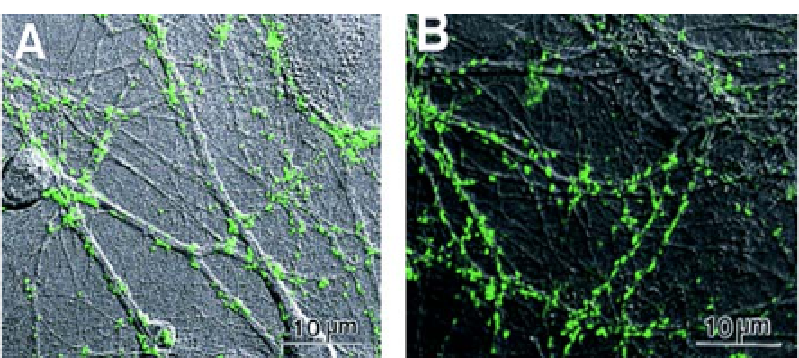Biomedical Engineering Reference
In-Depth Information
Fig. 8
Primary rat hippocampal neurons form active synapses on peptide scaffolds. The
confocal images show bright discrete
green labeling
indicative of synaptically active mem-
branes after FM1-43 incubation of neurons.
A
Active synapses on the peptide surface.
B
Active synapses on Matrigel. The active synapses on these different materials are not
readily distinguishable, indicating that the peptide scaffold is a permissible substrate for
synapse formation.
Bar
= 5-10 mm
producing a hydrogel material. The scaffolds can support neuronal cell at-
tachment and differentiation as well as extensive neurite outgrowth. Fur-
thermore, they are permissive substrates for functional synapse formation
between the attached neurons. That primary rat neurons form active synapses
on such scaffold surfaces in situ suggests these scaffolds could be useful for
tissue engineering applications. The buoyant self-assembling peptide scaf-
folds with attached cells in culture can be transported readily from one
environment to another. These biological materials created through molecu-
lar design and self-assembly may be developed as a biologically compatible
scaffold for tissue repair and tissue engineering [100].
Self-assembling peptides are being developed as scaffolds for tissue regen-
eration purposes, including cartilage repair and the promotion of nerve cell
growth [101]. A major benefit of synthetic materials is that they minimize
the risk of biological contamination. Self-assembling peptides also frequently
show favorable properties concerning biocompatibility, immunogenicity and
biodegradability, producing non-toxic waste products. The amphiphilic pep-
tide construct discussed above, containing a long hydrophobic tail linked to
a cell-recognizing tag, can be customized for specific cell response by tailor-
ing the sequence of the tag. Laminin is an extracellular matrix protein that
influences neurite outgrowth. A peptide amphiphile shown to promote the
re-growth of nerve cells in rats was made by including a neurite-promoting
laminin epitope tag, IKVAV (C16-G3A4-IKVAV) [102]. Another construct,
containing a heparin-binding site, shows very exciting preliminary results in
being able to promote angiogenesis, the growth of blood vessels [103]. These
types of peptide amphiphiles have been further modified with biotin [104]

